Cleaning Z-Scale Track
Dirty track is one of the plagues of small-scale railroading, and there's simply no way around it. The smaller the scale, the more easily dirt and corrosion can impede electrical conductivity between the rails and the locomotive wheels. Obstructions, such as ballast and bits of scenery, also need to be routinely vacuumed or brushed away.
The accumulation of dirt and corrosion is an ongoing process, thus is the necessity to clean track. Laziness, as much as necessity, is the mother of invention, so I present a few ways of cleaning Z-scale track.
Nearly all electrical contact between the locomotive wheels and the rails takes place on the tops of the rails, not the sides - luckily, that's the easiest place to clean. Now, there are several types of "dirt" that concern us:
The following solutions primarily cover the various products available for cleaning Z-scale track, and how to use them. You may find the best approach is to employ several of these methods, depending on the size of your layout and how often you run your trains.
In this article:
See also:
I welcome any and all comments, additions, and corrections you wish to email me. Click on any photo to see more detail.
Abrasive Track Cleaners
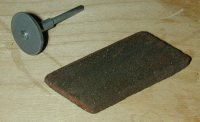 Mechanical track cleaning essentially involves a cleaning stone, stiff eraser block (e.g. "Bright Boy"), or other abrasive object rubbed against the track (found at any hobby store).
For severe corrosion, a rotary tool and a Dremel #425 polishing wheel (mounted on a Dremel #402 mandrel) does wonders on rails.
Mechanical track cleaning essentially involves a cleaning stone, stiff eraser block (e.g. "Bright Boy"), or other abrasive object rubbed against the track (found at any hobby store).
For severe corrosion, a rotary tool and a Dremel #425 polishing wheel (mounted on a Dremel #402 mandrel) does wonders on rails.
Abrasive cleaning is easy, quick, inexpensive, and can be used on small spots where needed. Ideally, rails should shine when they are clean.
There are several down sides, though. First of all, Z-scale rails are very thin and rather soft; too much mechanical cleaning will wear them out quickly. Secondly, it's a manual process, and a lot of work to do repeatedly, especially on a large layout. Thirdly, mechanical cleaning processes leave behind shavings, crumbs, and other residue which then must be vacuumed. Lastly, cleaning hard-to-reach areas (such as in tunnels) is no fun.
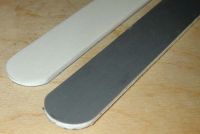 A new product, Trax Stix, is an answer to many of these concerns.
Trax Stix are essentially plastic sticks shaped like tongue depressors with two different cleaning pads, one on each side.
The white side is a very mild abrasive (1000 grit), strong enough to remove most of the grime build-up on the rails.
The gray side is more of a polisher (2500 grit), used to add that extra shine to the rails after using the white side.
A new product, Trax Stix, is an answer to many of these concerns.
Trax Stix are essentially plastic sticks shaped like tongue depressors with two different cleaning pads, one on each side.
The white side is a very mild abrasive (1000 grit), strong enough to remove most of the grime build-up on the rails.
The gray side is more of a polisher (2500 grit), used to add that extra shine to the rails after using the white side.
The advantages of Trax Stix is that they are much less harmful to Z-scale rails than stones, and leave much less of a mess when you're done cleaning.
They're also long and thin, able to clean hard-to-reach places with ease.
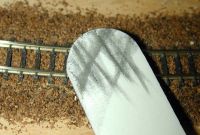 This shows the grime removed by about 2 seconds of light rubbing on a 6-inch segment of track.
This shows the grime removed by about 2 seconds of light rubbing on a 6-inch segment of track.
The results are fantastic: the rails appear to shine more and conduct electricity better, all with less effort than using a track cleaning stone. I've found the white side to be far more effective than the gray at cleaning (it would be nice to have white on both sides). Furthermore, the white side seems to absorb the grime amazingly well, meaning that much less dirt is left behind on and around the rails!
The downside is that they can wear out fast; the white abrasive tears easily (a problem that should be fixed in the retail product, to be released in November 2001) and both sides accumulate dirt quickly.
I used up 4-5 sticks cleaning my (admittedly large) layout just once.
However, you can't argue with results, so I do recommend them.
|
Where to get Trax Stix Trax Stix were originally available from Jay Greer of TRAX, INC.Graham Jones offers this advice: The sticks can be brought from a chemist [pharmacist] as ladies finger nail buffers. |
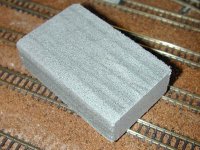 My most recent acquisition is a Roco 10002 track polisher.
Although it's somewhat more expensive than the other similar products (it retails for about $10), it's larger and less awkward to hold.
It's also much softer than most other track cleaning blocks, so the damage to the rails is minimal - it can even be cut into smaller pieces with a knife, making it easier to fit into tunnels and bridges.
So far, it's the best manual track cleaner I've used; my only complaint is that it can leave behind shavings that must be vacuumed up.
My most recent acquisition is a Roco 10002 track polisher.
Although it's somewhat more expensive than the other similar products (it retails for about $10), it's larger and less awkward to hold.
It's also much softer than most other track cleaning blocks, so the damage to the rails is minimal - it can even be cut into smaller pieces with a knife, making it easier to fit into tunnels and bridges.
So far, it's the best manual track cleaner I've used; my only complaint is that it can leave behind shavings that must be vacuumed up.
Chemical Track Cleaners
Specialized chemicals can be used to dissolve dirt and corrosion, usually without any rubbing or grinding. Examples, such as Rail-Zip or Seuthe 108, can be found at most hobby stores. Goo-gone, available at any drug, grocery, or hardware store, will probably do just as well.
The most important considerations in choosing a chemical cleaner is that it should evaporate quickly and completely, and that it shouldn't harm your scenery or rolling stock. In my limited experience with chemical cleaners, however, they just don't seem to work well enough to be used alone, and don't seem to make much of a difference if you're already cleaning your track mechanically.
A track cleaning car that slowly distributes a chemical cleaner would be a nice addition to an automated abrasive cleaner, as the chemical would theoretically help keep the track from accumulating more grime.
Another solution (one that I have yet to try) is rubbing or painter's alcohol, or (if you can find it) 99%-pure alcohol (not the drinking type). A chamois or other material that won't tear can then be used to wipe the rails.
Some Z-heads have reported success with Wahl Oil (used for cleaning electric hair clippers), although I haven't been able to reproduce any of the reported benefits myself. Search the Z_SCALE group archives for "wahl" to see the applicable discussions. (Click Next repeatedly to find older messages.)
Electronic Track Cleaners
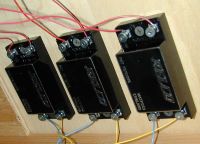 At first glance, electronic track cleaners seem like snake oil.
Essentially, whenever the unit senses a break in the circuit (signifying dirt on the track that is interrupting the flow of electricity to the locomotive), a high frequency electrical signal is superimposed on the track power, which ionizes the air gap and reestablishes electrical contact with the locomotive.
Yea, right.
At first glance, electronic track cleaners seem like snake oil.
Essentially, whenever the unit senses a break in the circuit (signifying dirt on the track that is interrupting the flow of electricity to the locomotive), a high frequency electrical signal is superimposed on the track power, which ionizes the air gap and reestablishes electrical contact with the locomotive.
Yea, right.
The most shocking thing about it (no pun intended) is that it actually works. I first tested an electronic track cleaner with my Marklin 8805 class 89 0-6-0 switcher. This particular locomotive is about more than 30 years old, and has never been able to make it all the way around my layout without lots of gentle nudging by yours truly. As soon as I connected the unit, the locomotive smoothly sped around my track without stopping once! Just to verify, I tried disconnecting the cleaner, and tried it again - sure enough, the little guy stopped about 2 seconds later.
To be realistic, electronic track cleaners do not really "clean" the track; more accurately, they help compensate for dirty track. In effect, they gives your locomotives that necessary nudge whenever it's needed, automatically and transparently. If you use it in conjunction with Trax Stix manual abrasive cleaners or perhaps a rolling stock cleaner, you will effectively eliminate the repeated stalling that plagues smaller Z-scale engines! And by doing so, you'll be able to run all your locomotives more reliably at slower, more prototypical speeds.
I've since permanently connected three electronic track cleaners to my layout (one for each track circuit), and have noticed varying levels of increased performance with each of my locomotives. Here are a few notes for hooking up electronic track cleaners to your layout:
If you find that electronic track cleaners are not for you, there are other ways to help reduce stalling on the tracks, including installing flywheels or large capacitors (500µF or higher, if you can find them small enough) in your locomotives, and wiring multiple locomotives together.
WHERE TO GET ELECTRONIC TRACK CLEANERS
Relco no longer makes the unit discussed in this article, but Gaugemaster makes a nearly-identical electronic track cleaner (the HF1 and HF2, for one or two circuits, respectively), as does Noch (#50150 and 50151, respectively).
You can get the Gaugemaster HF1 from Glenn and Sandy Stiska. You can sometimes find the Gaugemaster HF2 on eBay and from a handful of UK-based hobby shops.
|
Comments on the Relco Electronic Track Cleaner --Glenn and Sandy StiskaWe would like to offer our personal experiences with the Relco track cleaner and the [Rogue] GP38-2 and the FR Boxcab engines. We purchased a GP38-2 this past June and Harald's Lehigh Valley Boxcab Train Set in July. Both have been running on our layout for over 3 months now with 150 hours on each locomotive. They are both well and happy and have no ill effects from our Relco units. We have had track cleaners on our layouts since 1991 and several of our Marklin engines have an excess of 500 hours on them. Some of our new 5 pole locomotives have more than 100 hours on them. All run fine with no problems. Regular cleaning gives us a chance to take a good look at our engines and they are in tip top shape. When Glenn read about the Relco in an article in a 1991 issue of ZTrack Magazine, he decided that we should give one a try. We were amazed at how much it improved our running. I would clean tracks for hours and now it takes us minutes because the Relcos keep the track way, way cleaner. An unexpected plus is that the wheels on the engines and cars don't get the caked on dirt that we used to get before we installed the Relcos. We have to qualify that though. We clean our tracks with alcohol and a chamois before we run each night. From what we have found out over the years, the reason the Relco doesn't harm anything is that the amperage produced by it is very, very low. |
Rolling Stock Track Cleaners
The best cleaning solution is an autonomous track cleaning machine. An ideal track cleaning machine would have the following characteristics (in this order, front-to-rear):
Such a machine would have advantage of being able to clean an entire layout with as much effort as running a train around the track, and would have the additional benefit of being able to clean hard-to-reach track, such as in tunnels.
The down side is that I'm not aware of such a device (at least an ideal one) in existence. So, I'm slowly developing my own track cleaning car, and will write it up here when any success has been achieved. Meanwhile, here are some existing track cleaning rolling stock products:
MARKLIN SCHIENENREINIGUNGSWAGEN
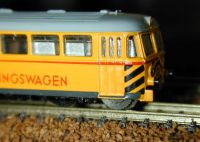 The Marklin 8802 / 88021 track-cleaning railbus has two serrated wheels that spin faster than the driving wheels, and are intended to remove foreign particles from the rails.
While it looks cool and makes a lot of noise, it unfortunately doesn't do too much to clean the grime that plagues Z-scale track.
If, however, you've been doing scenery, sanding, sawing, or anything else that produces fine, loose particles, the schienenreinigungswagen actually does a pretty good job of moving it off the rails.
The Marklin 8802 / 88021 track-cleaning railbus has two serrated wheels that spin faster than the driving wheels, and are intended to remove foreign particles from the rails.
While it looks cool and makes a lot of noise, it unfortunately doesn't do too much to clean the grime that plagues Z-scale track.
If, however, you've been doing scenery, sanding, sawing, or anything else that produces fine, loose particles, the schienenreinigungswagen actually does a pretty good job of moving it off the rails.
If you do use the railbus to clean your track, you may notice that the main cleaning wheels accumulate grit, and need to be cleaned with an X-acto knife.
If you don't routinely scrape the wheels, it will be far less effective.
MARKLIN JÖRGER TRACK CLEANING CAR
Released in 2001, the Marklin 86501 track cleaning car uses the Jörger system to clean track.
On the underside of the car, a removable cleaning pad gently rubs the rails as it rolls around the layout.
It comes with several, replaceable pads, and apparently, you can toss them in the laundry to clean them (although I don't think I'd want the grime it collects to get on my engineer's cap).
When I first got this car, I wasn't exactly blown away by its track-cleaning effectiveness; the dry pad just slid right over the grime.
So what I started doing is saturating the pad with Goo-Gone sticker-remover (available at any drug store or hardware store). Run the car around your layout with the Goo-Gone dripping off the pad, and you'll be amazed at how well it works. The nice thing is that Goo-Gone evaporates almost immediately, and all you're left with is clean track.
|
Comments on the Marklin 86501 Track Cleaner Very good results, though you need a heavy diesel loco to pull it in a train. You still need to clean manually at least every 3 weeks. Place the dirty pads in a tied sock in your laundry at no more then 40 degrees and they will last a long time. --Phil Risbridger |
AZTEC TRACK CLEANING CAR
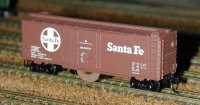 Aztec Manufacturing also makes a track cleaning car, but uses a different approach than the Marklin units.
They make two American prototype models, differing only on the Micro-Trains shell that is used (it's available as either a wood or steel 40' boxcar).
Unfortunately, it isn't powered, which means that it must be pushed or pulled by a separate locomotive, and there's no provision for chemical cleaners.
It only comes with Micro-Trains couplers, but one could easily replace them with Micro-Trains Marklin-Style couplers (#908) if needed.
Aztec Manufacturing also makes a track cleaning car, but uses a different approach than the Marklin units.
They make two American prototype models, differing only on the Micro-Trains shell that is used (it's available as either a wood or steel 40' boxcar).
Unfortunately, it isn't powered, which means that it must be pushed or pulled by a separate locomotive, and there's no provision for chemical cleaners.
It only comes with Micro-Trains couplers, but one could easily replace them with Micro-Trains Marklin-Style couplers (#908) if needed.
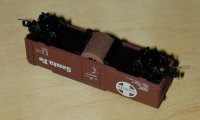 The abrasive roller is made of a material similar to a standard track cleaning stone, and is loosely inserted into the custom Aztec chassis.
Testing it was easy: I rolled the car over some obviously dirty track to see if it cleaned it.
Now, the Aztec car is a very passive cleaning device; there's nothing but the weight of the roller pressing against the rails, so I noticed absolutely no cleaning affect at all.
Then, I rolled the car over the same spot 5 or 6 times, and wouldn't you know it, it worked!
The abrasive roller is made of a material similar to a standard track cleaning stone, and is loosely inserted into the custom Aztec chassis.
Testing it was easy: I rolled the car over some obviously dirty track to see if it cleaned it.
Now, the Aztec car is a very passive cleaning device; there's nothing but the weight of the roller pressing against the rails, so I noticed absolutely no cleaning affect at all.
Then, I rolled the car over the same spot 5 or 6 times, and wouldn't you know it, it worked!
The roller isn't actually attached to the chassis, so it's able to roll freely, and there's virtually no resistance; the Aztec car rolls nearly as smoothly as a standard Micro-Trains car. The roller is mounted at a slight angle, enough to affect a gentle polishing of rails as it turns.
It wasn't able to completely clean the dirtier track on my layout, and the protrusions in turnouts prevented substantial cleaning (it had no trouble rolling over turnouts, though). It's more suitable as a preventative cleaner: used regularly, it should significantly decrease the amount of manual cleaning necessary.
Its appearance is also so innocuous that you could simply run it in a standard freight train on a regular basis to keep the track clean (I recommend putting it directly behind the locomotive so that its weight doesn't cause a problem with the other cars). You could also simply make a habit of pulling it around your track by itself for 20-30 minutes, say, once a week. At roughly $60.00, it isn't cheap, but those with a moderate-to-large sized American layout will most likely welcome this little fellow in the long run.
|
Comments on the Aztec Track Cleaner Concerning the Aztec car...every Z scale layout should have one. During train shows, I run 3 trains continuously on the Val Ease Central. Each train has an Aztec car behind the motive power to polish the track and to improve the performance of the trains. They work well on the home layout to condition the track after cleaning with another agent. The Aztec car will remove residue and particles left behind from the major cleaning operation. I usually run a locomotive with just the cleaning car for about 5 minutes around each circuit of the layout. You can see the grime and oil that is collected on the abrasive roller which is skewed 2 degrees from perpendicular to the track direction. As a result, the roller rolls while skidding along the rail head. This keeps drag to a reasonable level and provides the scrubbing effect that cleans the rails. Very ingenious on the part of John Claudino of Aztec. Putting the car further back in a train consist may cause derailments due or uncoupling because of the drag from this car. They are a little pricey but one per layout is a good investment. --Jeffrey MacHan |
Return Home | Search | Contact Me
Copyright © 2000-2010 D. A. Karp. All rights reserved.